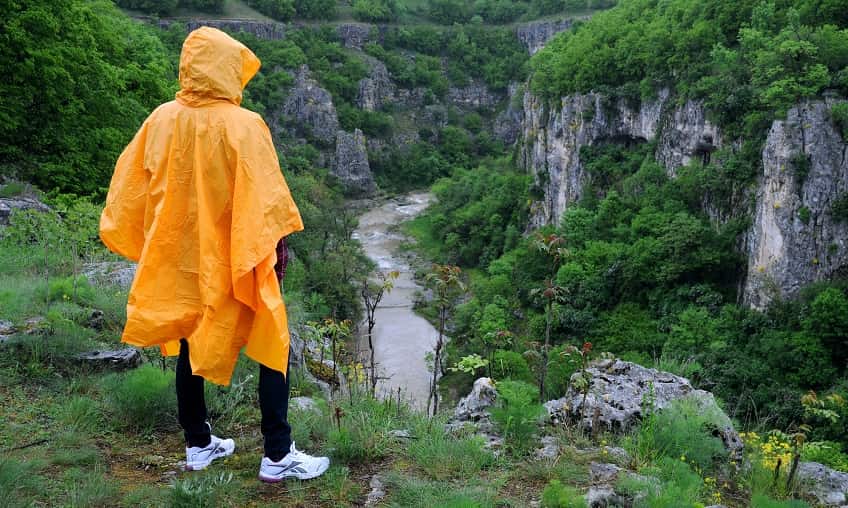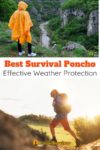[ad_1]
A survival poncho is lightweight, multi-purpose kit that’s likely to be a staple of your Bug Out Bag. Ponchos are inexpensive and can be used to keep you and your gear dry during a downpour, as an emergency shelter, or to collect rainwater.
On the downside, they’re not particularly practical in windy weather, and the one-size-fits-all approach won’t suit everyone.
A heavy-duty, breathable poncho will be more protective and durable if you live in a wet, cool climate. In drier climates, you may feel a lightweight emergency option is all you need.
Top Pick
HAZARD 4 Poncho
Durable, Breathable, Roomy
A well-designed robust poncho that is breathable to prevent moisture buildup inside.
Best Survival Poncho Reviews
Hazard4 Tactical Poncho: Best for durability
Size: 13″ L x 11.2″ W x 2.2″ D (folded) | Weight: 2.3 lbs | Material: Water-resistant breathable fabric
The Hazard4 poncho is designed to be worn as an everyday piece of outdoor kit, not just in emergencies. The breathable softshell fabric is heavier than most, making it less likely to blow up.
If you live in a warm climate, this may make it a bit too warm for your needs.
Although water beads on the fabric, we’d recommend using a waterproof treatment to add an extra layer of protection.
While it’s roomy enough to fit a medium-sized backpack underneath, it’s not a full-length poncho. This makes it a good option for shorter individuals.
The hood on the Hazard4 is the best we’ve seen. It’s generously sized, but drawstrings at the back and around the neck make it fully adjustable. It also has a high collar to prevent rain from leaking down your neck.
Rather than having a separate stuff sack, the poncho packs down into its front pocket – one less thing to lose! There are grommets at each corner and hook-and-loop patches on the front and back.
As you might expect, the trade-off for this robustness is extra weight. The Hazard4 poncho weighs over two pounds and will take up a good chunk of space in your Bug Out Bag. It’s also the priciest of the ponchos we’ve reviewed.
Hunting Rain Poncho: Runner up
Size: 55 (width) x 43 (folded length) inches | Weight: 11 oz | Material: 210T ripstop taffeta with polyurethane coating
The features on this lightweight poncho make it stand out from its competitors. It has front and back ventilation zips (also handy for accessing your backpack), a large chest pocket, and eight eyelets rather than the usual four.
It’s much lighter than the Hazard4, but there have been some reports of issues with poor construction, particularly around the grommets and snap buttons.
It’s also shorter than other models, giving less coverage for larger folk or those who want to wear a backpack underneath.
Cons
Mediocre construction
Shorter than other models
Foxelli Rain Poncho: Budget Pick
Size: 55 x 47.5 inches | Weight: 11 oz | Material: 210T high density PU3000MM coated polyester
A basic poncho that comes in a vast range of colors, the Foxelli poncho is aimed more at the general market than people looking for survival kit.
However, it’s compact, lightweight, and inexpensive, making it an excellent option for preppers on a budget or those living in drier climates who want something for the occasional rain shower.
The large hood has a drawstring cord and hook-and-loop fastening at the neck. The side fastenings are also hook-and-loop rather than snap buttons. These may be less likely to rip from the fabric, but they can become less effective as a fastening over time.
Cons
Not as durable as other ponchos
PREPARED4X Blanket Poncho: Best For Emergencies
Size: 50 x 47 inches | Weight: not specified | Material: 24-micron Mylar
This is basically a glorified mylar blanket and fills a specific niche. It’s designed to keep you warm and dry and help rescuers find you.
While we might automatically opt for a color that will help us remain hidden when SHTF, in many disaster situations, being able to attract the attention of a passing helicopter could save your life.
The reflective Mylar will help you retain body heat, and both the orange and the silver sides will do a good job of making you visible. Unfortunately, the hood is a bit of an afterthought, and there’s no cord to cinch it in.
Although it’s more robust than many lightweight survival blankets, it’s definitely not an everyday poncho. But it’s small enough to slip into your Bug Out Bag as a secondary poncho or keep in your car for emergencies.
Lingito Rain Ponchos Family Pack: Best Disposable
Size: 32 x 46 inches | Weight: Approx. 3.2 oz | Material: Plastic
Though they may be a glorified plastic bag, these ponchos have a place in your emergency kit.
Firstly, they’re one of the few ponchos that come in child sizes. They also come individually wrapped in a slim 7.5 x 6.5-inch package, making them handy to slip inside your Bug Out Bag or good for bartering.
This means you can’t open it up to use as a ground cover or shelter (unless you cut it), but it makes it a bit more effective at keeping rain from blowing up or through the sides of the poncho.
However, with a bit of ingenuity, you could use them to protect kit or to collect rainwater – something you may not want to use a more expensive poncho for.
What to Consider When Buying a Survival Poncho
Disposable vs. Reusable
Disposable ponchos are cheap, extremely lightweight, and usually made from plastic or PVC. Although they’re not durable enough for us to recommend as your primary poncho, they’re cheap enough that you can stockpile a supply.
You won’t be gutted if you end up punching a hole in one, and they could be a valuable commodity for bartering.
Reusable ponchos are more expensive, but they are more versatile and durable. This is what you’ll want in your Bug Out Bag, but if you have a bit of extra space, it may be worth squeezing in a couple of disposable ones as well.
Features
All ponchos should have a decent-sized, adjustable hood that won’t blow off your face in the first gust of wind.
Many have grommets sewn into the corners to use at attachment points (e.g., if you’re building a shelter or protecting supplies); some include pockets or ventilation zips.
Durability and Weight
When shopping for a poncho, you’ll need to trade off durability against weight and cost.
More expensive ponchos are made from durable fabrics but may be heavier and take up more space in your pack.
Cheap ponchos are usually more lightweight but are often poorly made and more likely to tear.
Size
Most ponchos come in a single size, but that doesn’t mean they’re all sized the same.
If you’re very petite, you may find ponchos impractically large. Conversely, you may struggle to fit one over you and your pack if you have a large build.
Ideally, a poncho wants to be large enough to cover you and your backpack. You may also want it to be big enough to shelter you and a companion or child if you’re sitting out a rainstorm.
Color
Most ponchos come in dark colors or a camouflage pattern designed for concealment. However, there are some situations when you want to be seen.
A bright orange poncho will help you attract attention if you’re injured or need help.
[ad_2]
Source link






